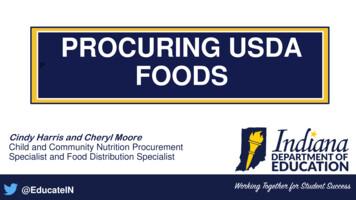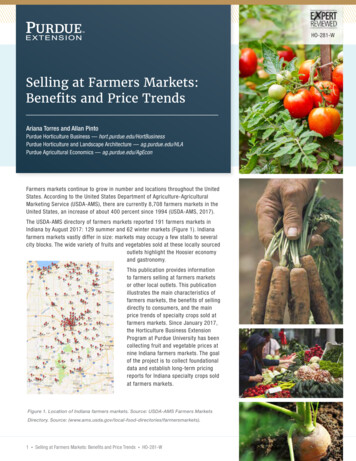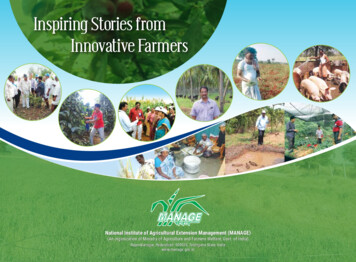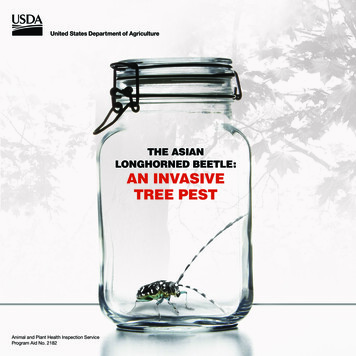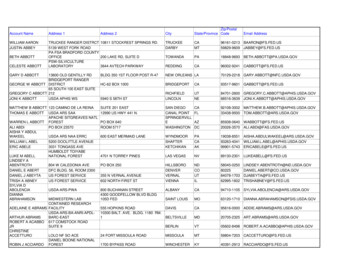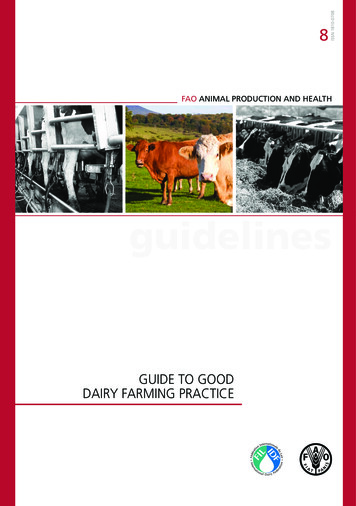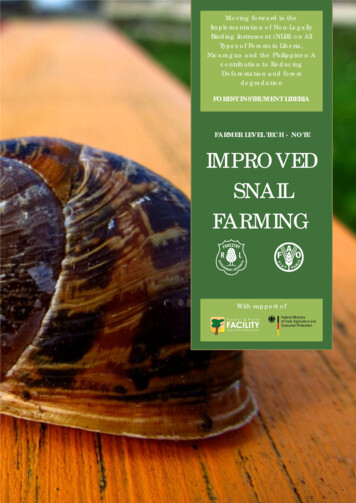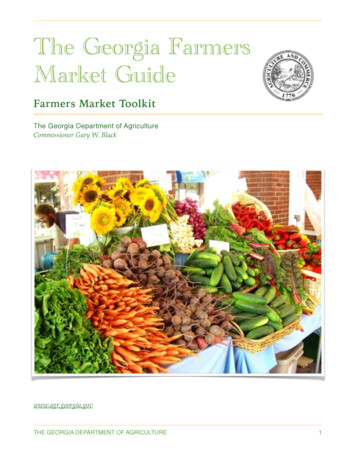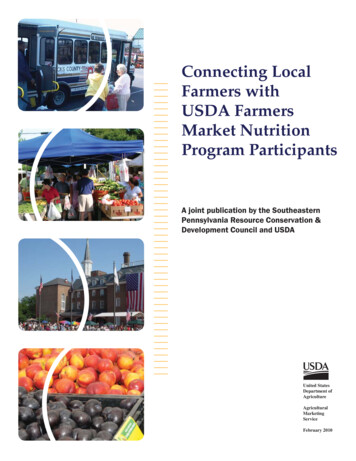
Transcription
Connecting LocalFarmers withUSDA FarmersMarket NutritionProgram ParticipantsA joint publication by the SoutheasternPennsylvania Resource Conservation &Development Council and USDAUnited StatesDepartment ofAgricultureAgriculturalMarketingServiceFebruary 2010
1000 East Walnut Street, Suite 704Perkasie, PA 18944Web: http://www.separcd.orgPhone: 215.453.9527 Ext 5Fax: 877.265.1846E-mail: chairman@separcd.orgThe U.S. Department of Agriculture (USDA) prohibits discrimination in all its programs and activities on the basis of race, color, nationalorigin, age, disability, and, where applicable, sex, marital status, familial status, parental status, religion, sexual orientation, geneticinformation, political beliefs, reprisal, or because all or a part of an individual’s income is derived from any public assistance program.(Not all prohibited bases apply to all programs.)Persons with disabilities who require alternative means for communication of program information (Braille, large print, audiotape, etc.)should contact USDA’s TARGET Center at (202) 720-2600 (voice and TDD). To file a complaint of discrimination write to USDA, Director,Office of Civil Rights, 1400 Independence Avenue, S.W., Washington, DC 20250-9410 or call (800) 795-3272 (voice) or (202) 7206382 (TDD). USDA is an equal opportunity provider and employer.The use of trade, firm, or corporation names in this publication is for the information and convenience of the reader. Such use does notconstitute an official endorsement or approval by the United States Department of Agriculture or the Agricultural Marketing Service ofany product or service to the exclusion of others that may be suitable.
Connecting LocalFarmers withUSDA FarmersMarket NutritionProgram ParticipantsAgreement No. 12-25-A-4604A joint publication by:Joanne NadovichSoutheastern Pennsylvania Resource and Conservation &Development CouncilJohn MetrickNatural Resources Conservation Service, USDAUnited StatesDepartment ofAgricultureAgriculturalMarketingServiceFebruary 2010i
ii
ContentsExecutive Summary1Introduction2Background32006 Market Season42007 Market Season62008 Market Season8Conclusions10Exhibits111.122006 Farmers Market Brochure2. 2006 Farmers Market Poster: English143. 2006 Farmers Market Poster: Spanish154. 2006 Farmers Market Trip Survey165.182006 FMNP Transportation Results6. 2007 Farmers Market Stipend Poster: English197.202007 Farmers Market Stipend Poster: Spanish8. 2007 Farmers Market Office Questionnaire219.232007 FMNP Transportation Results10. 2008 Focus Group Discussion Questionnaire24Photo Credits25iii
iv
Executive SummaryThe Farmers Market Transportation Project was initiatedby the Southeastern Pennsylvania Resource Conservationand Development (Southeastern PA RC&D) Council.Southeastern PA RC&D became aware of the lowredemption rates of Farmers Market Nutrition Program(FMNP) checks, particularly by Special SupplementalNutrition Program for Women, Infants, and Children (WIC)participants. Southeastern PA RC&D wanted to conducta study to determine if lack of transportation was theprimary factor for the low redemption rates. In 2004almost 40 percent of the FMNP checks issued to PAWIC participants were not redeemed, representinglost revenue of approximately 1.5 million toPennsylvania farmers.The Southeastern PA RC&D and the U.S. Department ofAgriculture (USDA) Agricultural Marketing Service (AMS)established a cooperative agreement in September 2005to conduct a study. The overall objective was to study thefeasibility of providing transportation services to Seniorand WIC participants in FMNP, other senior citizens,ethnic minorities, and low-income residents to farmersmarkets in Southeastern Pennsylvania.The Southeastern PA RC&D believes it is important,especially for mothers and young children, to eat freshfruit and vegetables frequently, as outlined in the USDAFood Pyramid. Southeastern PA RC&D also believesthat greater redemption of FMNP checks will increasesupport for and provide greater sustainability to farmersin the region.Hot Peppers & Parking Lot Peaches: Evaluating Farmers’Markets in Low Income Communities, by Andy Fisher ofthe Community Food Security Coalition (January 1999),discovered that lack of transportation was a significantbarrier for low-income individuals accessing farmersmarkets. Providing transportation to low-income seniorcitizens helped them visit farmers markets, was easy toschedule, and was successful. Providing transportationfor WIC participants was not as easy or successfuldue to other issues impacting WIC participants. TheSoutheastern PA RC&D believes that, althoughtransportation is a factor, other issues also prevent WICparticipants from redeeming more FMNP checks.1
IntroductionAMS promotes farmers markets and direct marketing offarm products. AMS recognized that some individualsparticipating in FMNP were not redeeming all of theirchecks and wanted to determine ways of raising theredemption rates.Southeastern PA RC&D and AMS started theTransportation—Connecting Local Farmers with USDAFarmers Market Nutrition Program Participants projectin September 2005 to determine whether lack oftransportation was a major reason for some lowincome individuals not redeeming their FMNP checks.The project was to test the concept that providingtransportation to FMNP participants and other lowincome individuals made sense, was economical,and increased redemption rates, thereby increasingfarmer income.To determine the answers to these study objectives,AMS provided financial and technical assistance to theSoutheastern PA RC&D. The results of the study willprovide additional information to farmers, farmersmarket operators, nutrition professionals, and thoseinvolved with FMNP.2
BackgroundReview of the 2004 Pennsylvania FMNP redemptionresults show that approximately 40 percent of the FMNPchecks issued to Pennsylvania WIC participants were notredeemed. This represents approximately 1.5 million inlost revenue to Pennsylvania farmers.With this information, the Southeastern PA RC&Dassembled a committee to provide guidance for theproject that included representatives from the followinggovernment agencies and community organizations:Penn State Cooperative Extension Service; county WICoffice supervisors; county offices of aging; communitydevelopment agencies; county transportationassociations; Maternal and Family Health, Inc.; PADepartment of Agriculture; and the USDA NaturalResources Conservation Service.In addition to this financial loss, opportunity is lost forcultivating future customers among the young childrenwho would accompany their parents to farmers markets,and the disconnect between food consumers and foodproducers continues to grow.Finally, health costs and concerns must be considered.Current dietary recommendations suggest that peopleshould eat five servings of fruit and vegetables a day.Eating enough fruits and vegetables is especially criticalin the development of young children as well as in helpingthem fight childhood diseases and offering protectionfrom lead poisoning.2004 FMNP Check Redemption RatesPA ton81%49%3
2006 Market SeasonFor Senior FMNP participants, the best alternative was tohire county or regional para-transportation companies.These organizations are formed mainly for transportingsenior citizens. Para-transportation buses are usuallymedium size, perfect for visiting smaller farmers markets,and handicap accessible. The para-transportationcompanies were supportive of the farmers markettransportation project and scheduled the trips aroundtheir normal transportation routes.The goal was to make it as easy as possible for SeniorFMNP participants and WIC FMNP participants to utilizethe provided transportation to farmers markets androadside stands.Senior FMNP ParticipantsIt was determined that working with community seniorcenters or low-income senior housing centers to organizetrips would be best. They were contacted and assisted inorganizing the trips. The Southeastern PA RC&D providedposters stating the date, time, and farmers market tobe visited. The centers coordinated the signups andcompiled a list of names for the Council. Southeastern PARC&D made arrangements for the transportation.In one location, para-transportation was not available;instead, motorized street trolley cars transported theseniors, which brought back fond memories for manyof them.WIC FMNP ParticipantsThese trips were successful, easy to administer, andrelatively inexpensive. Transportation service for seniorcitizens was relatively low in cost because it is subsidizedby the State of Pennsylvania. In some cases, local countygovernments also fund transportation for senior citizens.For WIC FMNP participants, providing transportation wascomplicated. Because children younger than 5 yearsmight accompany their mothers on the trips, child safetyhad to be addressed. Although very young childrenride on public transportation buses without safety carseats, they must ride in car seats in all other forms oftransportation. Pennsylvania law and the bus designdetermine the necessary requirements. On Pennsylvaniaschool buses, children age 5 and older do not need carseats. Because some of the children visiting farmersmarkets with their mothers could be younger than 5, theywere not allowed to ride on school buses. The privatebuses that were used required all children, even thoseover 5, to have safety car seats.For Senior FMNP participants, it was a day out andthey treated it almost as if it was a social event. Theyappreciated the transportation and the opportunity topurchase fresh, locally grown fruits and vegetables. Theseniors used most of their FMNP checks.The Council provided a farmers market ambassador toaccompany seniors on each trip who answered questionsabout eligible produce, redeeming FMNP checks, andwhich farmers at a market participate in FMNP. TheCouncil representative also helped load and unloadpurchases to and from the bus and provided informationabout the farm or farmers market visited.To help resolve the problem, Southeastern PA RC&Dpurchased some car seats and encouraged parents tobring their own. However, someone had to carry car seatsto the pickup sites, sometimes installing car seats in thebuses was not easy, and transportation companies hadto be told in advance if car seats were to be installedon the bus so they could ensure that the bus had extralong seatbelts. At the end of the trips, WIC participantswho brought their own car seats then had to carry theirfarmers market purchases, as well as their car seatsand children.Although providing transportation was key in the study,finding transportation providers became an unexpectedsource of problems. Southeastern PA RC&D had hopedto partner with public transportation agencies to providebusing to farmers markets. Unfortunately, the publictransportation companies were unable to provide busesor add routes to the farmers markets.4
WIC farmers market trips were promoted throughbrochures and posters distributed by the WIC office staffto their clients (Exhibits 1-3). In addition, posters andbrochures in both English and Spanish were distributedat churches and community centers. The posters andbrochures included a specific trip date, time, and farmersmarket to be visited. To make it easy for WIC participantsto sign up for trips, there was a toll-free telephonenumber to allow registration 24 hours a day, 7 days aweek. Bilingual telephone operators were available torecord trip registration information. Everyone liked theposters and brochures, and the toll-free telephone systemwas appreciated and easy to use.Senior and WIC FMNP participants who used theprovided transportation appreciated the service. Theyredeemed many or all of their FMNP checks and enjoyedthe farmers market.As with the Senior FMNP trips, farmers marketambassadors accompanied WIC clients on the trips. Allof the ambassadors were bilingual. They helped theWIC participants select fruits and vegetables eligible forpurchase with FMNP checks and redeem their FMNPchecks. They also served as liaisons between the WICrecipients and farmers market staff.Trip participant numbers can be viewed in Exhibit 5.On the return bus trip after visiting the farmers market,the survey (Exhibit 4) distributed to the participantsreceived mostly positive comments. The few concernsexpressed were related to limited selection of produceand higher prices than grocery stores. Notably, WICparticipants preferred fruits and vegetables that could beeaten with minimal preparation, such as tomatoes, sweetcorn, strawberries, apples, and peaches.While every effort was made to make the farmers markettrips as easy and fun as possible, WIC clients did notparticipate in the same numbers as the seniors.5
2007 Market SeasonTo further encourage WIC participants to visit farmersmarkets, a 75 stipend was offered if they organizedfarmers market trips for their fellow WIC participants andfriends. Posters in English and Spanish were displayed atWIC offices to advertise the program (Exhibits 6 and 7).Unfortunately there were no responses to the offer.The primary focus for 2007 was to increase thenumber of WIC individuals using the farmers markettransportation. Trips for seniors were also scheduledand continued to be relatively easy to organize, and thenumber of participants increased.A bilingual scheduling coordinator was hired to visit theWIC offices to help promote the transportation service,organize trips, and serve as contact for registering fortrips. The scheduling coordinator was also responsiblefor calling the registered WIC clients 24 to 48 hoursbefore a trip to remind them. Brochures and posters weredistributed, as they were in the 2006 market season.At the conclusion of the market season, the SoutheasternPA RC&D Council surveyed WIC participants aboutthe farmers market transportation project and theirvisits to farmers markets (Exhibit 8). WIC participantswere surveyed by an interviewer in 17 SoutheasternPennsylvania WIC offices.Some overall noteworthy items were:Although WIC trip participation numbers increased, theresponse was not strong enough to justify the effortexpended by the scheduling coordinator. Throughthis involvement, however, the coordinator gained anunderstanding of the issues other than transportationfacing WIC participants. Some WIC clientele did notparticipate in the trips for the following reasons: Some WIC clients were unaware of the farmers One or more children suddenly got sickWIC client gave birth to another childWIC client was pregnant and did not feel wellWIC client was physically tired from raising smallchildren The value of the FMNP check(s) was not worththe effort of preparing and taking young childrenon the trip Work schedule changed An excellent example of the problems encounteredwhen trying to organize a trip for WIC participantsoccurred when 31 WIC clients registered for a farmersmarket trip—100 including other family members. Whenreconfirming registrations 1 or 2 days before the trip, only14 WIC clients said they would be going on the trip; theothers dropped out for some of the reasons listed above.On the day of the trip, only one WIC client and three familymembers were at the pickup site.6market transportation trips. Their previousquarterly appointment had occurred beforetrip information was distributed and theyhad not been back to the office. Because ofconfidentiality requirements and often-changingcontact information, there is limited ability tocontact WIC participants between office visits.Some were new clients on their first visits to theWIC office and didn’t know about FMNP.Some clients were unpredictable about keepingWIC office appointments, either canceling themor not showing up.Some had skipped their previous quarterly visitsand no longer were receiving FMNP checks.Some had lost their checks.Some didn’t feel a trip to a farmers marketinstead of a grocery store was worth the timeand effort.
A majority (52 percent) of the survey participantsthought the WIC office was the best place to promote theFarmers Market Nutrition Program. Thirty-five percent ofthe interviewees thought that posters and flyers in thecommunity would also be a good way to promotethe program.Four hundred sixty-nine WIC participants wereinterviewed. Note that some participants chose not toanswer all of the questions in the survey.Three hundred nine respondents (66 percent) said theyreceived Farmers Market Nutrition Program checks in2007. Of those who received checks, 237 individuals(77 percent) received four checks worth 5 each. Theremainder received more checks. Those familiesreceiving more than four checks had more than oneeligible child.Eighty-eight percent of the respondents were not awareof free transportation service to a farmers market, andmost (90 percent) had not seen flyers promoting freetransportation service. Fifty-two percent of those whodid not use the transportation said it was because theyhad a car they could use to drive to the farmers markets.It was repeatedly mentioned that more advertising ofthe free transportation would have increased the use ofthe service.A majority of the FMNP checks were received in themonth of July (51 percent); June (22 percent) and August(19 percent) were the next highest distribution months.This coincides with the months that area farmers marketshave the greatest selection of fruits and vegetables.Participants said they go to farmers markets only whennecessary, but when they go they buy three to fivetypes of fruits and vegetables. Sixty-one percent of therespondents said they visit a farmers market only oncea year.Most recipients (70 percent) said they used all ofthe checks they received. Thirty-four percent of theindividuals who did not use all their checks stated theydid not have time to use them. Thirty-two percent statedthere were no farmers markets near them. Lack oftransportation to a farmers market was cited as areason by 11 percent of those who did not use all of theirFMNP checks.Trip participant numbers can be viewed in Exhibit 9.7
2008 Market SeasonSoutheastern PA RC&D provided copies of PennsylvaniaProduce—A Guide to Quality Produce Grown in PA to theWIC offices for distribution to WIC FMNP participants.The guide, developed by Penn State CooperativeExtension, contains information on ways to select anduse Pennsylvania-grown produce and gave its nutritionalcontent. The guides were provided to WIC participantsto help them select their purchases at farmers markets.Southeastern PA RC&D received the following commentsabout the guides: “We love them,” “Very informative,”“Very good instructions,” “They (WIC clients) really like itand said it was very helpful.”For these reasons, no farmer stands were set up near aWIC office. One farmer who did set up a stand severalblocks from the WIC office 1 day a week said that,although he accepted FMNP checks, the majority of hissales were to cash-paying customers. Southeastern PARC&D was unable to determine how soon after receivingFMNP checks seniors or WIC individuals redeemed themat this stand.Senior FMNP trips were also offered in 2008. Again,they were easy to schedule, coordinated with minimaloversight, and appreciated by the senior citizens. Nofarmers market ambassadors were provided; rather,the organizing centers were responsible for providing atrip leader.To make it as easy as possible for WIC clients to redeemtheir FMNP checks, the project shifted its focus tobringing a farmers market to the WIC clients. Thehope was to have one or more farmers set up a standat or near the WIC offices, allowing WIC participantsto purchase locally grown fresh fruit and vegetablesimmediately after receiving their FMNP checks. Toencourage farmers to participate in the project, a stipendwould be offered to help cover some of the additionalcosts associated with the new farm stand.At the conclusion of the 2008 market season, five focusgroup meetings were scheduled to determine whatmotivates Senior FMNP and WIC FMNP recipients toshop at farmers markets. Each focus group used a list ofdiscussion questions provided by the council (Exhibit 10).The results of the focus group discussions show that bothgroups like shopping at farmers markets because theyare sources of fresh, locally grown fruits and vegetables.They like going to farmers markets because they believelocal farmers use fewer pesticides and the quality of thefruits and vegetables is higher. They also enjoyed visitingon-farm stands to visit the countryside and see where thefood was grown. They mentioned their disappointment inthe higher prices charged at farmers markets than thoseat grocery stores. They were also disappointed that somecommunity farmers markets were open only certain daysand hours. A reason given by both groups for not usingFMNP checks was that the checks tended to get lost ormisplaced until it was too late to use them. Also somefelt it was not worth a trip to a farmers market to redeemone or two checks.Several of the WIC offices were located in urban areaswith high vehicular traffic, where space (parking lot, park,etc.) was not readily available to set up a farm stand nearthe office. One WIC office was located in a governmentowned building with an adjacent parking lot, but buildingadministrators did not consider a farmers market to be anappropriate use of their facilities.In addition, farmers, even with the offer of 150 per daystipend, were not interested in participating in the project.Many had made substantial investments already toattract customers to their on-farm stands, or had previouscommitments to other community farmers markets, andcould not take on another site. Some farmers neededtheir staff to harvest crops and run existing markets. Thefarmers were concerned about needing to train (andtrust) new people and put them alone at a market stand.Finally, the farmers were concerned that the pool ofpotential customers would be too small and sales levelswould not justify the time and effort.8
Senior FMNP participants sometimes bought specificfruits and vegetables because of the recipe cardsprovided with the FMNP checks. Cabbage was a favoritevegetable. Generally, seniors purchase both fruits andvegetables, and they tend to cook their vegetables on astove. The Reading Farmers Market in Philadelphia wasa favorite place for seniors to visit because of its largesize and variety of offerings. In their opinion, localcommunity farmers markets tend to have limitedselections and fewer stands that accept FMNP checks.Some seniors had problems carrying their purchasesaround farmers markets.Two efforts are being planned by local counties asa followup to this study. The Chester County HealthDepartment is scheduling a farmers market for countyemployees at a government center. The goal is toencourage employees to buy and eat healthier foodsduring the summer months. A WIC clinic is located in thebuilding, and clients will be able to shop at the market.The health department is going to work with the WIC staffto encourage the WIC clients to visit the market afterappointments at which they get FMNP checks.Also, a housing shelter in Reading, Berks County, plansto operate a small farmers market at the shelter for itsclients and residents of the surrounding city blocks. Manyshelter clients and community residents receive eitherSenior or WIC FMNP checks.WIC participants learned ways to use fruits andvegetables from watching TV celebrity chefs. Theypurchased fruit primarily in the summertime and selectedvegetables that could be eaten as snacks with ranchdressing. WIC participants prefer using a microwavefor cooking. They would like more farmers to sell fruitsand vegetables they prefer, such as starfruit, bananas,plantains, kale, and collards. Such preferences reflectthe ethnic composition of the WIC participants, of whomalmost 70 percent were Hispanic and 22 percent wereAfrican American (unlike the senior participants, whowere mostly white). See exhibits 5 and 9 for the completeethnic breakdown for WIC and Senior FMNP participants.The commonly stated preference for tropical fruit speaksto the difficulty of promoting local food consumption inimmigrant communities. WIC participants also wishedthey could use food stamps at farmers markets.9
ConclusionsThe study was designed to determine if transportationwas a limiting factor in the redemption of Senior andWIC FMNP participants. It appears the Senior FMNPredemption rate will improve if transportation is provided.The WIC FMNP redemption rate appears to be limited byfactors outside the realm of this study.Senior FMNP trips were easy to schedule and coordinateand were successful, with the participants or centersrequesting additional trips. Cancellation amongthe seniors was low, and everyone appreciated thetransportation assistance to farmers markets. Almost allbuses operated at or near capacity.Para-transportation companies already transport manyof the same clientele as FMNP recipients and are familiarwith their needs. Once the companies became familiarwith the process and farmers market destinations, theywere eager to assist and expand their services.While check redemption rates are high (more than80 percent) for Senior FMNP participants in the studycounties, it would not take much effort to increase thoserates and even encourage seniors to spend personalfunds at farmers markets. For many seniors, goingto a farmers market was a social event as well as anopportunity to buy fresh fruit and vegetables. Theirschedules are flexible with minimal time constraints.Because State and local funding helps to underwritesome of the transportation costs already for seniorcitizens, transporting Senior FMNP participants tofarmers markets is relatively inexpensive. Placing afarmers market ambassador on the buses was reassuringand helpful to many senior citizens. Senior centers andhousing complexes appreciate being able to offer anotheractivity for their clients.Providing Senior FMNP recipients with transportationto farmers markets is a good idea for several reasons.Redemption rates can be raised, seniors get anopportunity to have a healthier diet, and revenues areincreased for farmers.Offering transportation assistance to WIC clients,however, may not lead to increased FMNP checkredemption rates. There appear to be many other factorsimpacting a WIC client’s decision on whether to ridethe provided transportation to a farmers market. Smallchildren, sudden illnesses, pregnancy, and other familyissues made it difficult for WIC clients to commit and/orfollow through with the commitment. WIC staff noted thateven scheduled appointments at the clinics sometimesare canceled or skipped.Although they liked going to the farmers markets andenjoyed buying fresh fruit and vegetables for themselvesand their young children, some WIC recipients wonderedwhether it was worth the effort for 20 (the value of theirFMNP check) worth of fruits and vegetables.Renting and scheduling the right type and size of buswas difficult. Providing and installing car seats was acumbersome process. The large difference between thenumbers of people who signed up and those who actuallyshowed up for the buses was frustrating for organizers.Also, because some communities did not have farmersmarkets or markets close by that accepted FMNPchecks, transportation times averaged 30 minutes ormore each way.Those who did use the transportation service appreciatedand enjoyed the trip. Unfortunately, full buses were rare.Also, public transportation for low-income non-seniorcitizens is not supported by government funding, makingit harder to provide a cost-efficient farmers markettransportation service.It was difficult to locate farmers markets/stands nearthe urban WIC offices. At many sites there was littleor no space available for a stand. Many farmers werefocused on bringing customers to their own farm standsor fulfilling commitments to other farmers markets. Newfarmers who are looking for places to sell their produceare possible candidates for stands in these locations.Finally, farmers were concerned that selling only to peoplevisiting the WIC office that day would not be profitable.If standard public transportation buses could havebeen rented or special public transportation “farmersmarket” routes created, providing transportation to WICparticipants would have been easier and perhaps moresuccessful.In summary, it appears that, although lack oftransportation may be a partial impediment to farmersmarket patronage among WIC clients, it is notnecessarily the primary factor that influences theirshopping decisions. As outlined above, several otherfactors impact WIC clients’ decisions on whether to visit afarmers market.10
Exhibits1. 2006 Farmers Market Brochure2. 2006 Farmers Market Poster—English3. 2006 Farmers Market Poster—Spanish4. 2006 Farmers Market Trip Survey5. 2006 Southeastern PA RC&D Council FMNPTransportation Results6. 2007 Farmers Market Stipend Poster—English7. 2007 Farmers Market Stipend Poster—Spanish8. 2007 Farmers Market Office Questionnaire9. 2007 Southeastern PA RC&D Council FMNPTransportation Results10. 2008 Focus Group Discussion Questions11
Exhibit 1: 2006 Farmers Market Brochure12
13
Exhibit 2: 2006 Farmers Market Poster, English Version14
Exhibit 3: 2006 Farmers Market Poster, Spanish Version15
Exhibit 4: 2006 Farmers’ Market Trip SurveyDoes your family receive FMNP checks?YesNoDon’t knowDoes your family use FMNP checks?YesNoDon’t knowIf you do us FMNP checks, how many were used today?12345Did this trip help increase your family’s use of fresh fruits and vegetables?YesNoDon’t knowHow much cash did your family spend at this market today?NoneUp to 5From 5 to 10More than 10Did your family learn about local food today?YesNoDon’t knowDid your family learn about local farms today?YesNoDon’t knowIs your family
February 2010 Agreement No. 12-25-A-4604. ii. iii Contents Executive Summary 1 Introduction 2 Background 3 2006 Market Season 4 2007 Market Season 6 2008 Market Season 8 Conclusions 10 Exhibits 11 1. 2006 Farmers Market Brochure 12 2. 2006 Farmers Market Poster: English 14 3.
